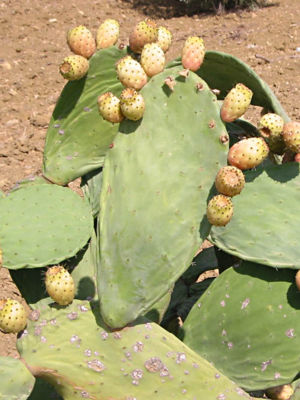- Opuntia ficus-indica
-
Opuntia ficus-indica 
Feigenkaktus (Opuntia ficus-indica) mit Früchten
Systematik Ordnung: Nelkenartige (Caryophyllales) Familie: Kakteengewächse (Cactaceae) Unterfamilie: Opuntioideae Tribus: Opuntieae Gattung: Opuntien (Opuntia) Art: Opuntia ficus-indica Wissenschaftlicher Name Opuntia ficus-indica (L.) Mill. Opuntia ficus-indica ist eine Pflanzenart in der Gattung der Opuntien (Opuntia) aus der Familie der Kakteengewächse (Cactaceae). Das Artepitheton ficus-indica bedeutet ‚indische Feige‘. Die Früchte sind essbar und werden Kaktusfeigen genannt. Die jungen Blätter sind ebenfalls essbar und gehören zur mexikanischen Standardküche.
Inhaltsverzeichnis
Beschreibung
Opuntia ficus-indica wächst strauchig oder baumartig und erreicht Wuchshöhen zwischen 1 bis 6 Metern. Meist ist ein deutlicher Stamm von bis zu 35 Zentimetern vorhanden. Die unterschiedlich geformten grünen Triebabschnitte sind schmal bis breit verkehrt eiförmig oder länglich. Sie sind 20 bis 60 Zentimeter lang und 10 bis 25 Zentimeter breit. Die schmal elliptischen Areolen stehen 2 bis 5 Zentimeter voneinander entfernt. Sie sind mit braunen oder gelben Glochiden besetzt, die bald abfallen. Die Dornen sind unauffällig und fehlen oft ganz.
Die Blüten stehen endständig am Spross, sind gelb bis rot und haben einen Durchmesser von 5 bis 10 Zentimeter. Die eiförmigen bis länglichen, grünen, orangen oder roten Früchte sind 6 bis 10 Zentimeter lang. Sie sind mit Glochiden und manchmal mit Dornen besetzt.
Systematik und Verbreitung
Opuntia ficus-indica stammt vermutlich aus Mexiko. Durch die lange Kultivierung der Art ist das ursprüngliche Verbreitungsgebiet nicht bekannt. Die Art ist in Südamerika, Australien und im Mittelmeergebiet verwildert. Molekulargenetische Untersuchungen deuten darauf hin, dass Opuntia ficus-indica eine domestizierte Form von Opuntia megacantha ist.[1]
Die Erstbeschreibung als Cactus ficus-indica wurde 1753 von Carl von Linné vorgenommen.[2] Philip Miller stellte sie 1768 in die Gattung Opuntia.[3]
Nutzung
Verzehrt wird das Innere der Frucht mit den ebenfalls essbaren Kernen. Das, je nach Sorte, gelborange bis rote Fruchtfleisch hat einen süß-säuerlichen Geschmack. Die Frucht kann man wahlweise roh, als Marmelade oder als Likör Bajtra genießen.
Nachweise
Literatur
- Edward F. Anderson: Das große Kakteen-Lexikon. Eugen Ulmer KG, Stuttgart 2005 (übersetzt von Urs Eggli), ISBN 3-8001-4573-1, S. 459.
Einzelnachweise
- ↑ M. Labra, F. Grassi, M. Bardini, S. Imazio, A. Guiggi, S. Citterio, E. Banfi and S. Sgorbati: Genetic relationships in Opuntia mill. genus (Cactaceae) detected by molecular marker. In: Plant Science. Band 165, Nr. 5, S. 1129–1136, 2003
- ↑ Species Plantarum. Band 1, S. 468, Lars Salvius: Stockholm 1753
- ↑ Gardeners Dictionary. 8. Auflage, London 1768, (ohne Seitenzahlen)
Weiterführende Literatur
- M. Patrick Griffith: The origins of an important cactus crop, Opuntia ficus-indica (Cactaceae): new molecular evidence. In: American Journal of Botany. Band 91, S. 1915–1921, 2004, online.
- H. G. Zimmermann, V. C. Moran: Biological control of prickly pear, Opuntia ficusindica (Cactaceae), in South Africa. In: Agriculture, Ecosystems & Environment. Band 37, Nummer 1–3, 1991, S. 29–35, doi:10.1016/0167-8809(91)90137-M.
Weblinks
 Commons: Opuntia ficus-indica – Album mit Bildern und/oder Videos und AudiodateienKategorien:
Commons: Opuntia ficus-indica – Album mit Bildern und/oder Videos und AudiodateienKategorien:- Opuntia (Kakteen)
- Opuntia
Wikimedia Foundation.

